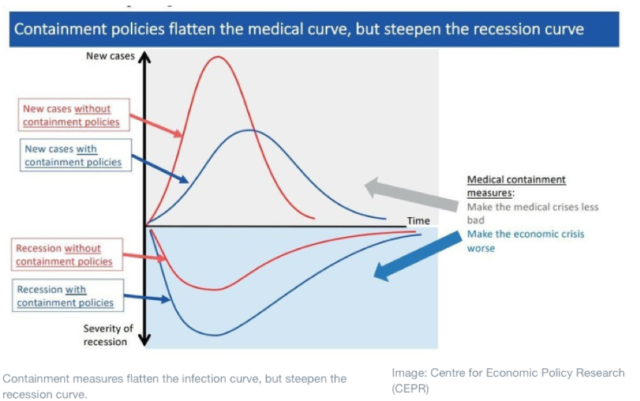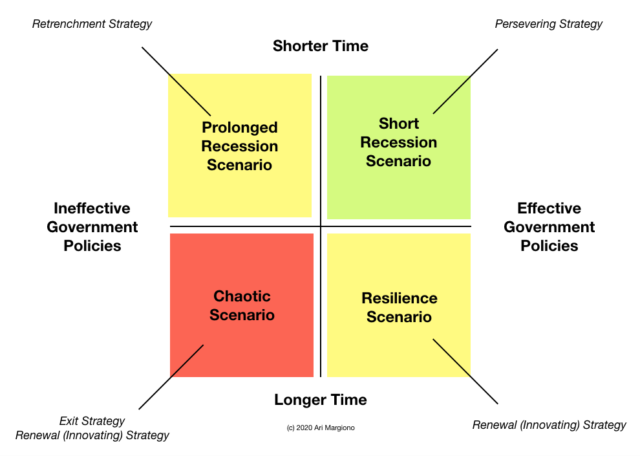What Might Post-Covid-19 Business Strategies Look Like?

Dr. Muhammad Ariono Margiono
Head of Center for Innovation, Design, and Entrepreneurship Research at BINUS University International
BINUS BUSINESS SCHOOL lecturer
COVID-19 will most likely change the way we do our business in the future; and the way we make important decisions today will affect how we will live our lives tomorrow. Executives and entrepreneurs need to be able to foresee the future to ensure that they can survive the upcoming disruptions. What are the alternative future business strategies that executives and entrepreneurs might need to look at?
Economists, political scientists, public health specialists, and many experts have offered their thoughts on surviving the COVID-19 pandemic.
As an example, a few economists and political scientists believe that allocating funds to help protect the health of the general public is, first and foremost, what many governments have to do. They need to provide incentives and introduce initiatives to “flatten the curve” (see figure 1). In the long run, packages to kickstart the economy need to be poured in for businesses to survive. Public health officials believe that accessible SARS-COV-2 vaccines and medicines are important and these may take 12–18 months or longer to reach the general public.

Figure 1. Economists believe that containment policies will flatten the medical but may steepen the recession curve. Therefore, governments must “act fast and do whatever it takes” to fight COVID-19 (see at: https://bit.ly/2V0Tw6o)
While there are so many perspectives coming from experts all around the world, their insights seem to boil down to two essential factors that determine how our life would be in the future.
These factors represent the two determinants of the alternative futures that may be impactful, and the variations of these factors may change the ways we live our future lives regardless of the certainty of their occurrence (Cairns and Wright, 2017; Crainer, 2014).
The first factor is the time required towards building a global public immunity against the SARS-COV-2 virus; and the second factor is the extent to which governments around the world effectively tackle the economic and political impacts of COVID-19.
These two factors serve as major dimensions that determine the scenarios of the future world; and, the combinations of these factors would lead to our alternative futures of business.
Figure 2 highlights the four plausible future scenarios and the corresponding business strategies that companies may subsequently take.

Figure 2. The plausible scenarios and the corresponding business strategies
The first scenario is a world where businesses will return to normal after a short recession. This is a future world after the COVID-19 pandemic where the time required to achieve global public immunity is short and the governments around the world offer appropriate measures to handle the economic and political contagion. This may be a situation where cheap SARS-COV-2 vaccines and medicines are available throughout the world.
This is also a future where most governments manage to flatten the curve and offer appropriate economic packages to citizens and businesses to survive and to kickstart the economy after the virus has receded. This is the ideal scenario that we all aim to achieve.
However, companies may receive shocks from the decline of their revenues due to various disruptions in their operational activities, but they may persevere and survive — thanks to the relatively short time to reach immunity from the virus, which will allow people to go back to normal life with adequate government support.
In a crisis situation like this, companies might need to take what Wenzel, Stanske, and Lieberman (2020) point out as the persevering business strategy. Companies adopting this strategy aim to maintain their business at a time of crisis. Companies that utilize this strategy attempt to find ways to ensure that their businesses operate as usual throughout the crisis. An example would be the use of existing cash reserves (or long-term loans) to pay for the financial losses until everything goes back to normal.
The second scenario is a world in a prolonged recession. Despite the accessibility of COVID-19 vaccines and medicines to many people around the world, the governments are ineffective and slow in tackling the economic and political issues. This world may be familiar since this is a world that is similar to the 1930’s great depression, or any other recent economic crisis. While receiving government financial support might be a luxury, businesses need to adapt to the new environment by embracing a retrenchment strategy (Wenzel et al., 2020).
A company that embraces a retrenchment strategy opts for significant cost reduction and downsizing tactics to ensure that the company floats during the prolonged economic crisis. This strategy helped many companies to survive for a longer period until things went back to normal.
The third scenario is a world where the market is resilient because the governments have been active and supportive despite the longer time required to find the vaccines and the cure for COVID-19.
This scenario will give rise to a new normal. Companies are no longer able to do things business as usual. Health screening, physical distancing, moving most business activities online, transforming the size and the structure of the organizations, etc. will become the day-to-day activities that many companies will have to do. Governments may assist and provide incentives for companies moving into this direction.
Thus, an innovating strategy (Wenzel et al., 2020) may be the most appropriate choice for businesses in this scenario’s world. Businesses worldwide will have to be very good in the health, safety, and environment (HSE) aspects and many of them may use online business strategies. These may become important basic elements of a new business model innovation for this particular era.
The fourth scenario is a chaotic world where global public immunity from SARS-COV-2 is rather long to achieve, and many governments are unable to maintain public health as health facilities and the economy become overburdened. This world will be characterized by a massive slowdown in the economy because people are unable to work due to widespread infections and illnesses. This is a scenario that we all would like to avoid.
In this scenario’s world, companies may need to consider an exit strategy, such as discontinuing the business (Wenzel et al., 2020) to reduce potential losses. However, at the same time, exiting companies may consider innovating by reallocating old resources to a new business model. For example, owners and companies that are driven by altruistic values might set up new social enterprises — a specific form of organizations that have unique business model designs to offer value at a time of simultaneous government and market failures (Santos, 2012; Margiono, Zolin, Chang, 2018).
References
Cairns, G., & Wright, G. (2017). Scenario thinking: Preparing your organization for the future in an unpredictable world. Springer.
Crainer, S. (2014). Future thinking. Business Strategy Review, 25(3), 77–77.
Santos, F. M. (2012). A positive theory of social entrepreneurship. Journal of business ethics, 111(3), 335–351.
Margiono, A., Zolin, R., & Chang, A. (2018). A typology of social venture business model configurations. International Journal of Entrepreneurial Behavior & Research.
Wenzel, M., Stanske, S., & Lieberman, M.B. (2020). Strategic responses to crisis. Strategic management journal. doi: 10.1002/smj.3161
Source: https://medium.com/@ari.margiono/what-might-post-covid-19-business-strategies-look-like-1d004848774f
